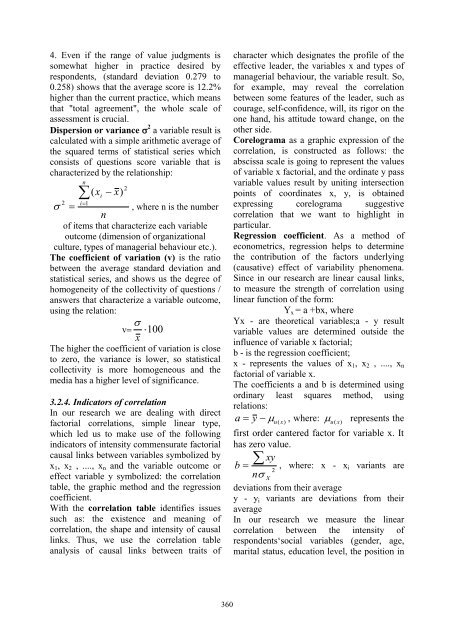Selected papers~ SPECIAL EDITION - Index of
Selected papers~ SPECIAL EDITION - Index of
Selected papers~ SPECIAL EDITION - Index of
You also want an ePaper? Increase the reach of your titles
YUMPU automatically turns print PDFs into web optimized ePapers that Google loves.
4. Even if the range <strong>of</strong> value judgments is<br />
somewhat higher in practice desired by<br />
respondents, (standard deviation 0.279 to<br />
0.258) shows that the average score is 12.2%<br />
higher than the current practice, which means<br />
that "total agreement", the whole scale <strong>of</strong><br />
assessment is crucial.<br />
Dispersion or variance � 2 a variable result is<br />
calculated with a simple arithmetic average <strong>of</strong><br />
the squared terms <strong>of</strong> statistical series which<br />
consists <strong>of</strong> questions score variable that is<br />
characterized by the relationship:<br />
n<br />
�<br />
�<br />
xi<br />
� x<br />
i<br />
�<br />
n<br />
1<br />
2<br />
( )<br />
2<br />
� , where n is the number<br />
<strong>of</strong> items that characterize each variable<br />
outcome (dimension <strong>of</strong> organizational<br />
culture, types <strong>of</strong> managerial behaviour etc.).<br />
The coefficient <strong>of</strong> variation (v) is the ratio<br />
between the average standard deviation and<br />
statistical series, and shows us the degree <strong>of</strong><br />
homogeneity <strong>of</strong> the collectivity <strong>of</strong> questions /<br />
answers that characterize a variable outcome,<br />
using the relation:<br />
�<br />
v� �100<br />
x<br />
The higher the coefficient <strong>of</strong> variation is close<br />
to zero, the variance is lower, so statistical<br />
collectivity is more homogeneous and the<br />
media has a higher level <strong>of</strong> significance.<br />
3.2.4. Indicators <strong>of</strong> correlation<br />
In our research we are dealing with direct<br />
factorial correlations, simple linear type,<br />
which led us to make use <strong>of</strong> the following<br />
indicators <strong>of</strong> intensity commensurate factorial<br />
causal links between variables symbolized by<br />
x1, x2 , ...., xn and the variable outcome or<br />
effect variable y symbolized: the correlation<br />
table, the graphic method and the regression<br />
coefficient.<br />
With the correlation table identifies issues<br />
such as: the existence and meaning <strong>of</strong><br />
correlation, the shape and intensity <strong>of</strong> causal<br />
links. Thus, we use the correlation table<br />
analysis <strong>of</strong> causal links between traits <strong>of</strong><br />
360<br />
character which designates the pr<strong>of</strong>ile <strong>of</strong> the<br />
effective leader, the variables x and types <strong>of</strong><br />
managerial behaviour, the variable result. So,<br />
for example, may reveal the correlation<br />
between some features <strong>of</strong> the leader, such as<br />
courage, self-confidence, will, its rigor on the<br />
one hand, his attitude toward change, on the<br />
other side.<br />
Corelograma as a graphic expression <strong>of</strong> the<br />
correlation, is constructed as follows: the<br />
abscissa scale is going to represent the values<br />
<strong>of</strong> variable x factorial, and the ordinate y pass<br />
variable values result by uniting intersection<br />
points <strong>of</strong> coordinates x, y, is obtained<br />
expressing corelograma suggestive<br />
correlation that we want to highlight in<br />
particular.<br />
Regression coefficient. As a method <strong>of</strong><br />
econometrics, regression helps to determine<br />
the contribution <strong>of</strong> the factors underlying<br />
(causative) effect <strong>of</strong> variability phenomena.<br />
Since in our research are linear causal links,<br />
to measure the strength <strong>of</strong> correlation using<br />
linear function <strong>of</strong> the form:<br />
Yx = a +bx, where<br />
Yx - are theoretical variables;a - y result<br />
variable values are determined outside the<br />
influence <strong>of</strong> variable x factorial;<br />
b - is the regression coefficient;<br />
x - represents the values <strong>of</strong> x1, x2 , ...., xn<br />
factorial <strong>of</strong> variable x.<br />
The coefficients a and b is determined using<br />
ordinary least squares method, using<br />
relations:<br />
a y � � � represents the<br />
� u(x<br />
) , where: u(x<br />
)<br />
first order cantered factor for variable x. It<br />
has zero value.<br />
� xy<br />
b � , where: x - xi variants are<br />
2<br />
n�<br />
X<br />
deviations from their average<br />
y - yi variants are deviations from their<br />
average<br />
In our research we measure the linear<br />
correlation between the intensity <strong>of</strong><br />
respondents‘social variables (gender, age,<br />
marital status, education level, the position in


